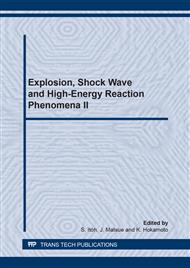p.40
p.46
p.52
p.60
p.68
p.74
p.80
p.86
p.92
Study on Behavior of Underwater Shock Wave in Enclosed Vessel
Abstract:
We are developing the food processing system by using the underwater shock wave. The effect of the underwater shock wave on the pressure in the vessel is the important factor for food processing system in this research. The purpose of this study is to research the behavior of the underwater shock wave in the enclosed vessel to investigate the influence of the contour of the elliptical vessel on the pressure. In this research, we used the elliptical shape for the vessel and the explosive was used to generate the shock wave. Numerical calculation was carried out by using LS-DYNA. The ratio of the length of the major axis to minor axis of the elliptical were changed, as a main parameter. As a result, it was found that underwater shock wave was generated and propageated in the elliptical vessel following the explosion. The underwater shock wave was coverged at the focal point. At the same time, the pressure was increased by the coverged underwater shock wave at the focal point in the all elliptical vessels. It was also found that the peak pressure at the focal point was determined by the contour of the elliptical vessel.
Info:
Periodical:
Pages:
68-73
Citation:
Online since:
July 2013
Price:
Сopyright:
© 2014 Trans Tech Publications Ltd. All Rights Reserved
Share:
Citation:


